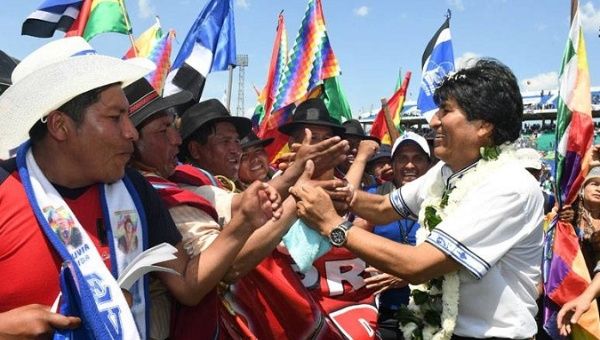Hate For the Indian
 Alvaro Garcia Linera
Alvaro Garcia Linera
Odio hacia los Indios
[dropcap]F[/dropcap]ascism, racial hatred, is not only the expression of a failed revolution but, paradoxically also in postcolonial societies, the success of an achieved material democratization.
Like a thick night fog, hatred rages through the neighborhoods of traditional urban middle classes in Bolivia. Its eyes overflow with anger. They don’t shout, they spit; They don’t complain, they impose. Their songs are neither of hope nor of brotherhood, they are of contempt and discrimination against the Indians. They ride their motorcycles, get in their SUV’s, gather in their carnival fraternities and private universities and go on the hunt for uppity Indians who dared to take away their power.
Like a thick night fog, hatred rages through the neighborhoods of Bolivia’s traditional urban middle classes. Their eyes are brimming with anger. They don’t shout, they spit. They don’t make appeals, they impose their will. Their chants are neither hopeful nor fraternal, but they ring with discrimination and contempt for indios (indigenous Bolivians). They mount their motorcycles and saddle up in their SUVs, band together with their buddies from the fraternities and private universities, and set off hunting for the rebellious indios who dared snatch power from their hands.
In Santa Cruz [a traditional center of the white, conservative, and pro-corporate “civic” opposition to Morales], they organize hordes of 4x4s, armed with clubs to scare the indios who live in the poorest neighborhoods and the markets — those whom they call “collas.” They shout that “you have to kill the collas” — and if they come across a woman in indigenous dress, they beat her, they threaten her, and they tell her to get out. In Cochabamba, they organize convoys to enforce their racial supremacy in the south of the city, home to the poorer classes. They charge like a cavalry unit into the thousands of defenseless peasant women who march for peace.
They carry baseball bats, chains, gas grenades. Some brandish firearms. Women are their favorite victims. They grab the mayor of a rural town, they humiliate her, drag her down the street, hit her, urinate on her. When she falls to the ground, they cut her hair, they threaten to lynch her, and when they realize they are being filmed, they cover her in red paint, a symbol of what they will do with her blood.
In La Paz, they are suspicious of their servants and do not speak when they bring food to the table. Deep down they fear them, but they also despise them. Later, they go out to the streets to shout, they insult Evo and, with him, all the indios who dared to build a cross-cultural democracy based on equality. When they gather in a crowd, they drag the Wiphala — the indigenous flag — through the dirt, spit on it, stamp on it, tear it, burn it. They unleash their rage against this symbol of the indios, who they’d like to wipe off the earth, along with all those who recognize themselves in this symbol of indigenous dignity.
Racial hatred is the political language of the traditional middle class in Bolivia. All their academic degrees, travels abroad, and religious faith count for nothing — in the end, everything pales before their ancestry. Deep down, their imagined lineage is stronger; this obsession oozes from their racist language, their visceral gestures, and their corrupted morals.
Explosion
All of this exploded on Sunday, October 20, when Evo Morales won the presidential elections, coming in more than ten percentage points ahead of the second-place finisher. However, the margin of victory was not so great as it was in the past, and Evo’s vote fell below 51 percent. But that was enough of a signal for the regressive forces waiting to oust him: from the timid liberal opposition candidate, to the ultraconservative political forces, to the Organization of American States (OAS), to the ineffable traditional middle class.
Evo had won again, but he no longer had 60 percent of the electorate with him, like before. He was weaker, and it was time for them to move against him. The losing candidate refused to recognize his defeat. The OAS spoke of “clean elections” but a diminished victory, and called for a second round of voting. (The OAS’s proposal contradicted the Constitution, which states that if a candidate has more than 40 percent of the votes and a lead greater than 10 percent over the second-place candidate, then the leading candidate is elected.)
And the middle class threw itself into the hunt for indios. On the night of Monday, October 21, five out of nine of the election authority’s offices were burned, including ballot boxes. The city of Santa Cruz decreed a civic strike that first rallied inhabitants in the central areas of that city and then spread to residential areas in La Paz and Cochabamba. And then the terror broke out.
Paramilitary bands began to besiege institutions, burn trade-union headquarters, and set fire to the homes of the candidates and leaders of the Movement toward Socialism (MAS), the ruling party. Even the president’s private home was ransacked. In other places, families, including children, were kidnapped and threatened with flogging and burning if, for instance, their father, serving as a government minister or a union leader, did not resign from his position. A long-anticipated Night of the Long Knives was unleashed, and fascism showed its face.
When the popular forces mobilizing to resist the civil coup began to regain territorial control of the cities, as workers, miners, peasants, indigenous people, and the urban poor flooded into the streets — and the balance of forces began to tip in their favor — the police mutiny began.
Over several weeks, the police had shown great incompetence and neglect of their duty to protect the ordinary people whom fascistic gangs threatened with beatings and persecution. But since last Friday — refusing to recognize their civilian command — many of these same police have shown an extraordinary capacity for attacking, detaining, torturing, and killing protesters from the popular classes. Of course, in the earlier [anti-Morales] protests, it had been a matter of reining in the children of the middle classes — and the police were supposedly powerless to react. But now that the task was to repress rebellious indios, the police’s arrogance and repressive fury reached monumental proportions.
The same happened with the armed forces. Throughout our administration, we never allowed the repression of civilian demonstrations, not even during the first civic coup d’état attempt in 2008. But after the elections, amid an enormous upheaval, and without us asking them anything, the police declared that they had no riot gear, that they had barely eight bullets per officer, and that a presidential decree would be required for them to be present in the streets in a deterrent capacity. However, the security forces did not hesitate to demand and enforce president Evo Morales’s resignation, fracturing the constitutional order.
The security forces tried their best to kidnap Morales when he headed toward the El Chapare province to seek refuge — and even after he had arrived. And when the coup was consummated, the security forces took to the streets, shooting thousands of bullets, militarizing the cities, killing peasants. Of course, they did all this without any presidential decree. When asked to protect indios, a decree was required. But when it came to repressing and killing indios, obedience to racial and class hatred was sufficient. In just five days, there are already more than eighteen dead, and more than 120 people have suffered gunshot wounds. Of course, all of them are indigenous.
Rising Fascism
The question we must answer is why the traditional middle class incubated so much hatred and resentment toward the people — leading them to embrace a racialized fascism, targeting the indio as an enemy. How did it infect the police and armed forces with its class frustrations, creating a social basis for fascistization, a basis for state regression and moral degeneration?
We are witnessing the rejection of equality, that is, the rejection of the very foundations of a meaningful democracy.
Over the past fourteen years, the main characteristic of the government — based on the social movements — has been the process of social equalization. It has cut extreme poverty sharply (from 38 to 15 percent of population), expanded rights for all (with universal access to health care, education, and social protection) and mounted an “Indianization” of the state (more than 50 percent of officials in the public administration have an indigenous identity, and there is a new national narrative formed around an indigenous base). It has also reduced economic inequalities (a decline in the income differential between richest and poorest, from 130 to 45). That is, the government presided over the systematic democratization of wealth and access to public goods, opportunities, and state power. During those fourteen years, Bolivia’s GDP grew from $9 billion to $42 billion, expanding the market and internal savings. This allowed many people to have their own home and improve their working conditions.
In fact, in just one decade, the percentage of people in the so-called “middle class,” as measured by income, increased from 35 to 60 percent of the population. Most of this rise came from the popular and indigenous sectors. The democratization of social goods through the construction of material equality inevitably led to a rapid devaluation of the economic, educational, and political capital possessed by the traditional middle classes. Previously, the traditional middle classes’ surnames, their monopoly over legitimate professional, academic, and political knowledge, and their family ties had allowed them access to positions in the public administration, to credit, and to jobs and scholarships.
However, today, the number of people fighting for the same positions or opportunities has doubled — reducing by half the possibilities for the old middle classes to access these goods. In addition to that, the “arribistas,” or upstarts, in the new, indigenous middle class of popular background have forms of social capital (indigenous languages, trade union links) that are, in fact, of greater value — not to mention state recognition of their status in the competition for available public goods.
We thus face a collapse of what was characteristic of colonial societies: ethnicity as capital, that is, the imagined foundation of the middle class’s historical superiority over the subaltern classes. And here in Bolivia, social class is only comprehensible and visible in the form of racial hierarchies. The fact that the children of the old middle classes have been the shock troops of the reactionary insurgency is the violent cry of a new generation that sees that their inheritance — their surname and their skin — is diminishing in the face of the democratization of social goods.
They may well wave banners for democracy, which they understand narrowly as one election. But they have actually rebelled against democracy, understood as the equalization and distribution of wealth. This explains the overflowing of hatred, the outpouring of violence. Racial supremacy is not rational; it is lived as a prime physical impulse, like a tattoo preserving colonial history.
Hence, fascism and racial hatred are not only consequences of a frustrated revolution, they are also, paradoxically, reactions against the achievement of material democratization in postcolonial societies.
Therefore, it is not surprising that while the Indians gather twenty of their own shot dead in the streets, the coup’s material and moral perpetrators claim that they have done so in order to safeguard democracy. In reality, they know that what they are doing is protecting the privilege of their caste and their good names.
Racial hatred can only destroy, it does not provide a future horizon. It is nothing more than primitive revenge carried out by a historically and morally decadent class, a revenge demonstrating that behind each mediocre liberal hides a committed coup supporter.
 Good people do exist. They will change this world
Good people do exist. They will change this world
When your heart fills with desperation, frustration, and despair, contemplating the state of the world and what humans have done, think of Leonardo's example.
[bg_collapse view="link-inline" color="#4a4949" expand_text="Learn about it here." collapse_text="Close" ]
Known for his great generosity, Leonardo was in the habit of purchasing and releasing little birds. He was also one of the earliest known ethical vegetarians. According to Melzi, his longtime friend, principal heir and executor, he viewed the oppression of humans and the enslavement of animals for human profit and benefit as a form of gross primitive injustice. And although many potentates sought his friendship and company, he remained until the end an unwavering egalitarian. [/bg_collapse]
[premium_newsticker id="211406"]
Read it in your language • Lealo en su idioma • Lisez-le dans votre langue • Lies es in Deiner Sprache • Прочитайте это на вашем языке • 用你的语言阅读
[google-translator]
[/su_spoiler]
THE DEEP STATE IS CLOSING IN
![]() The big social media —Google, Facebook, Instagram, Twitter—are trying to silence us.
The big social media —Google, Facebook, Instagram, Twitter—are trying to silence us.

THIS WORK IS LICENSED UNDER A Creative Commons Attribution-NonCommercial 4.0 International License





